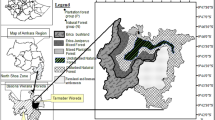Abstract
We conducted an extensive survey in search of hybrid baboons betweenPapio hamadryas andP. anubis along the Wabi-Shebeli river at the border of the Arusi and Bale Regions, Ethiopia. We made inquiries of villagers on the roadsides concerning the existence of baboon species. We also conducted direct observations at several sites. There are three routes which lead to the north bank of the Wabi-Shebeli river (Arusi Region), and we found hybrid baboons on the bank of the Wabi-Shebeli river in two routes among the three. We found hamadryas baboons in all of the three routes at the cliff areas. There are two routes which lead to the south bank of the Wabi-Shebeli river (Bale Region). We conducted a survey on one of the two. We found hamadryas baboons at the cliff areas of the route.
We observed a population of gelada baboons along the cliff extending over 20 km along the north bank of the Wabi-Shebeli river (Arusi Region). This area is far to the south of the known distribution range of gelada baboons (Yalden et al., 1977). The gelada baboons of this area appeared to represent a different form (subspecies?) from those at Debre Sina (Showa Region) based on our observations in both areas.
We reached the conclusion that the distributions of baboon species along the Wabi-Shebeli river may have been strongly affected by the intensive cultivation on the plateau of the highland. The distribution patterns of the three baboon species,P. anubis, P. hamadryas, andTheropithecus gelada, appeared to be influenced by their individual adaptabilities to the cliff environment. Hamadryas baboons were distributed continuously along the cliff and the narrow lowland of the Wabi-Shebeli river. Anubis baboons were distributed discontinuously on the cliffs, and their populations tended to be small and isolated. These anubis baboons were strongly hybridized with hamadryas baboons.
Similar content being viewed by others
References
Dunbar, R. I. &P. Dunbar, 1974. On hybridization betweenTheropithecus gelada andPapio anubis in the wild.J. Human Evol., 3: 187–192.
Groves, C. P., 1972. Phylogeny and classification of Primates. In:Pathology of Simian Primates, Vol. 1,R. N. T. W. Fiennes (ed.), Karger, Basel, pp. 29–57.
Haltenorth, T. &H. Diller, 1980.A Field Guide to the Mammals of Africa Including Madagascar. Collins, London. (English translation byR. W. Hayman)
Iwamoto, M., 1980. On the distribution of baboons in Ethiopia.J. Anthropol. Soc. Nippon, 88: 387–397. (in Japanese with English abstract)
Kawai, M. &K. Sugawara, 1976a. Hybridization and the evolution of primates. (1) Social structure of a hybrid baboon group betweenPapio anubis andPapio hamadryas.Shizen, 31(11): 48–57. (in Japanese)
—— & ——, 1976b. Hybridization and the evolution of primates. (2) Speciation and homization.Shizen, 31(12): 64–73. (in Japanese)
Nagel, U., 1973. A comparison of anubis baboons, hamadryas baboons, and their hybrids at a species border in Ethiopia.Folia Primatol., 19: 104–165.
Neumann, O., 1902. Kurze Mitteilung uber die zoologischen Resultate meiner Expedition durch Nordost-Afrika 1900–1901.Verh. 5te. Int. Zool. Congr. Berlin 1901, 201–208.
Phillips-Conroy, J. &C. Jolly, 1986. Changes in the structure of the baboon hybrid zone in the Awash National Park, Ethiopia.Amer. J. Phys. Anthropol., 71: 337–350.
Pucheran, J., 1857. Notices mammalogiques.Rev. Mag. Zool., (2), 9: 243.
Shotake, T., 1981. Population genetical study of natural hybridization betweenPapio anubis andPapio hamadryas.Primates, 22: 285–308.
Strack, D. &H. Frick, 1958. Beobachtungen an äthiopischen Primaten.Zool. Jb. (Syst.), 86(1–2): 41–70.
Sugawara, K., 1979. Sociological study of a wild group of hybrid baboons betweenPapio anubis andP. hamadryas in the Awash Valley, Ethiopia.Primates, 20: 21–56.
——, 1982. Sociological comparison between two wild groups of anubis-hamadryas baboons.Afr. Stud. Monogr., 2: 73–121.
Yalden, D. W., M. J. Largen, &D. Kock, 1977. Catalogue of the mammals of Ethiopia, 3. Primates.Monitore Zoologico Italiano N. S. Supplemento IX, 1: 1–52.
Author information
Authors and Affiliations
About this article
Cite this article
Mori, A., Belay, G. The distribution of baboon species and a new population of gelada baboons along the Wabi-Shebeli river, Ethiopia. Primates 31, 495–508 (1990). https://doi.org/10.1007/BF02382533
Received:
Accepted:
Issue Date:
DOI: https://doi.org/10.1007/BF02382533




